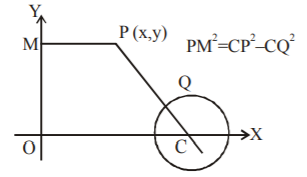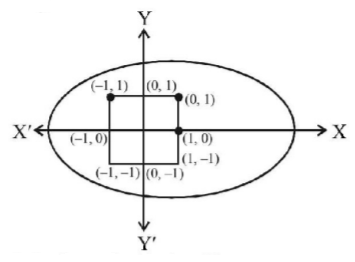11. The locus of the point of intersection of two tangents of the ellipse $$\frac{{{x^2}}}{{{a^2}}} + \frac{{{y^2}}}{{{b^2}}} = 1$$ which are inclined at angles $${\theta _1}$$ and $${\theta _2}$$ with the major axis such that $${\tan ^2}{\theta _1} + {\tan ^2}{\theta _2}$$ is constant, is :
A
$$4{x^2}{y^2} + 2\left( {{x^2} - {a^2}} \right)\left( {{y^2} - {b^2}} \right) = k{\left( {{x^2} - {a^2}} \right)^2}$$
B
$$4{x^2}{y^2} - 2\left( {{x^2} - {a^2}} \right)\left( {{y^2} - {b^2}} \right) = k{\left( {{x^2} - {a^2}} \right)^2}$$
C
$$4{x^2}{y^2} - 2\left( {{x^2} - {a^2}} \right)\left( {{y^2} - {b^2}} \right) = k{\left( {{x^2} + {a^2}} \right)^2}$$
D
None of these
Answer :
$$4{x^2}{y^2} - 2\left( {{x^2} - {a^2}} \right)\left( {{y^2} - {b^2}} \right) = k{\left( {{x^2} - {a^2}} \right)^2}$$
12. The equation $$\frac{{{x^2}}}{{1 - r}} - \frac{{{y^2}}}{{1 + r}} = 1,\,\,\,r > 1$$ represents :
A
an ellipse
B
a hyperbola
C
a circle
D
none of these
Answer :
none of these
13. The locus of a point $$P\left( {\alpha ,\,\beta } \right)$$ moving under the condition that the line $$y = \alpha x + \beta $$ is a tangent to the hyperbola $$\frac{{{x^2}}}{{{a^2}}} - \frac{{{y^2}}}{{{b^2}}} = 1$$ is :
A
an ellipse
B
a circle
C
a parabola
D
a hyperbola
Answer :
a hyperbola
14. The locus of the mid-point of the line segment joining the focus to a moving point on the parabola $${y^2} = 4ax$$ is another parabola with directrix :
A
$$x = - a$$
B
$$x = - \frac{a}{2}$$
C
$$x = 0$$
D
$$x = \frac{a}{2}$$
Answer :
$$x = 0$$
15. The equation $$2{x^2} + 3{y^2} - 8x - 18y + 35 = k$$ represents :
A
no locus if $$k>0$$
B
an ellipse if $$k<0$$
C
a point if $$k=0$$
D
a hyperbola if $$k>0$$
Answer :
a point if $$k=0$$
16. A point moves such that the square of its distance from a straight line is equal to the difference between the square of its distance from the centre of a circle and the square of the radius of the circle. The locus of the point is :
A
a straight line at right angle to the given line
B
a circle concentric with the given circle
C
a parabola with its axis parallel to the given line
D
a parabola with its axis perpendicular to the given line
Answer :
a parabola with its axis perpendicular to the given line
17.
Two sets $$A$$ and $$B$$ are as under :
$$\eqalign{
& A = \left\{ {\left( {a,\,b} \right) \in R \times R:\left| {a - 5} \right| < 1{\text{ and }}\left| {b - 5} \right| < 1} \right\}; \cr
& B = \left\{ {\left( {a,\,b} \right) \in R \times R:4{{\left( {a - 6} \right)}^2} + 9{{\left( {b - 5} \right)}^2} \leqslant 36} \right\}. \cr} $$
Then :
A
$$A \subset B$$
B
$$A \cap B = \phi \,\,\left( {{\text{an empty set}}} \right)$$
C
$${\text{neither }}A \subset B{\text{ nor }}B \subset A$$
D
$$B \subset A$$
Answer :
$$A \subset B$$

